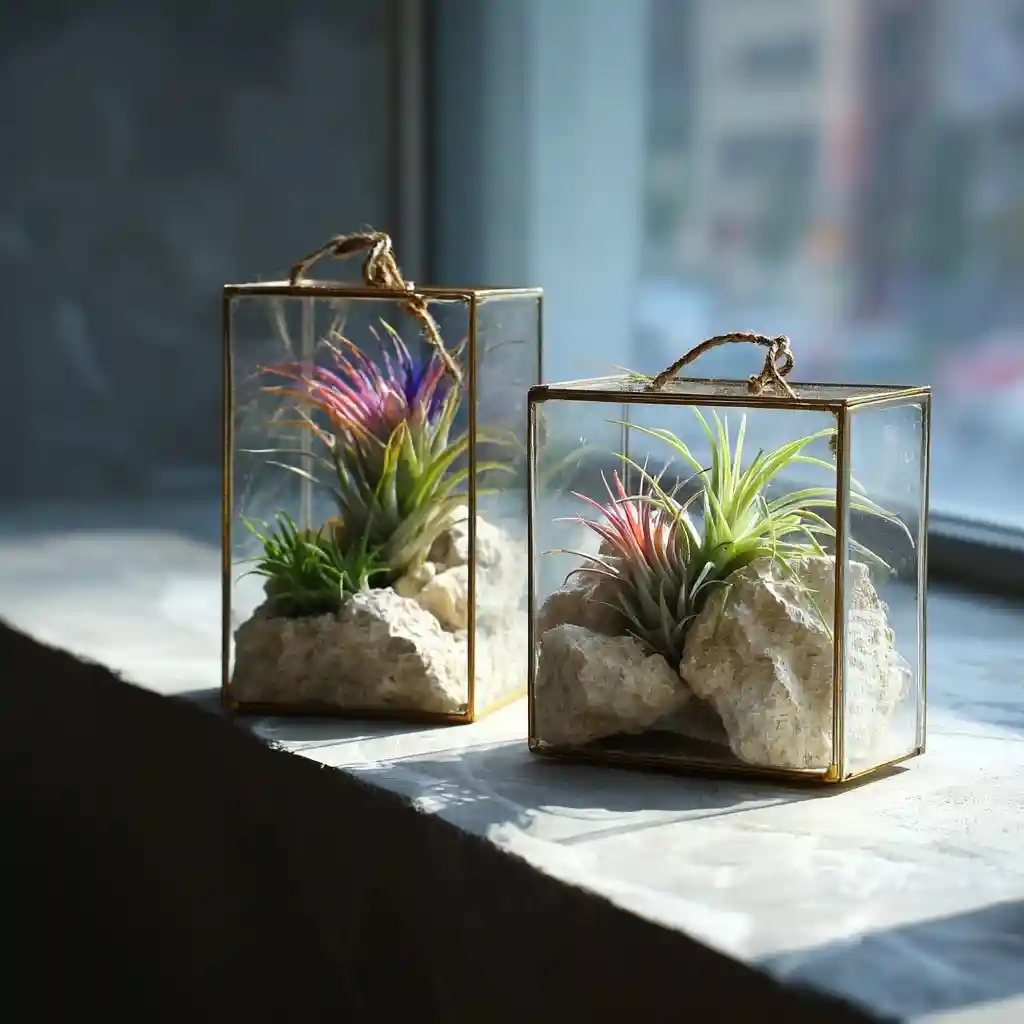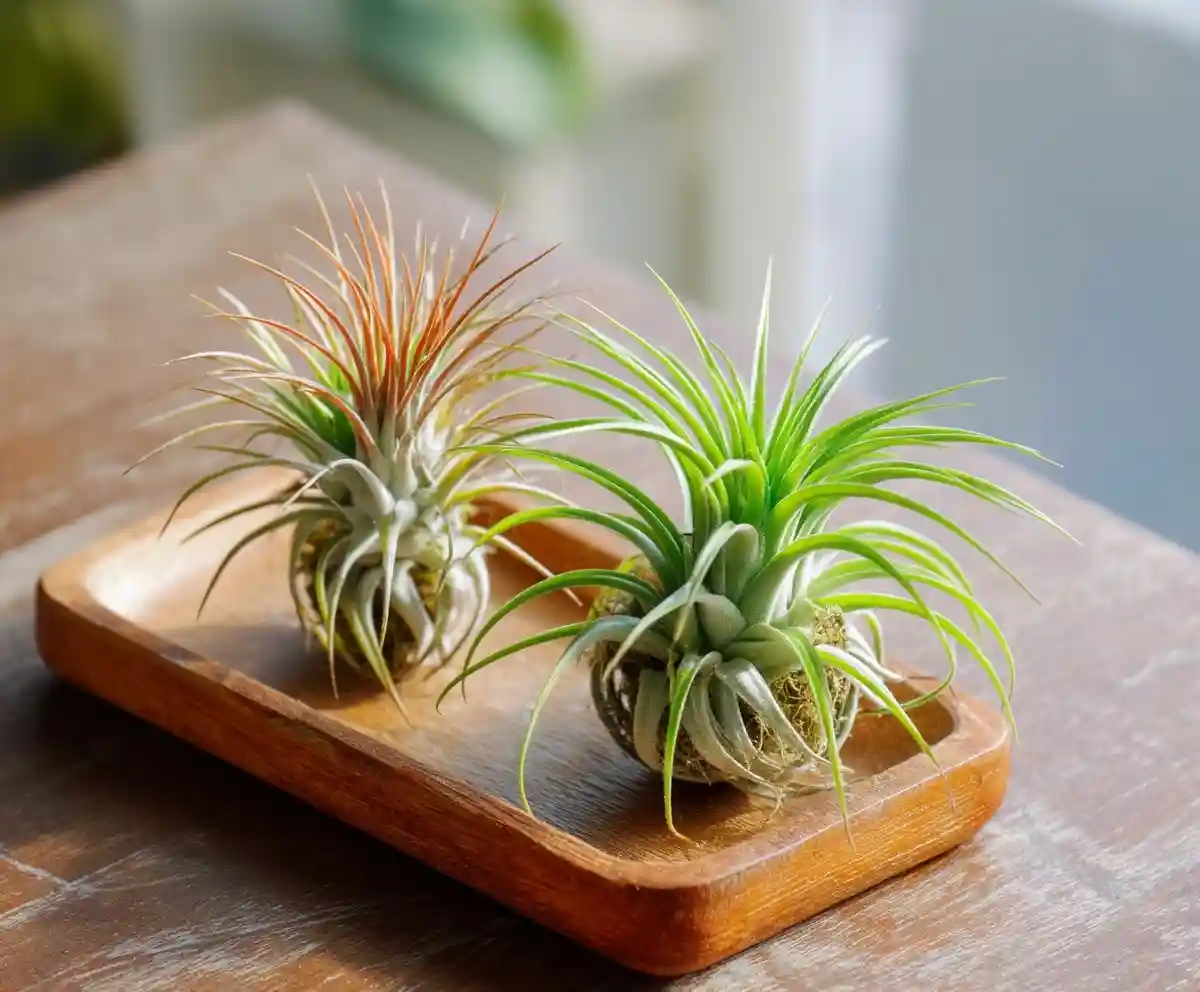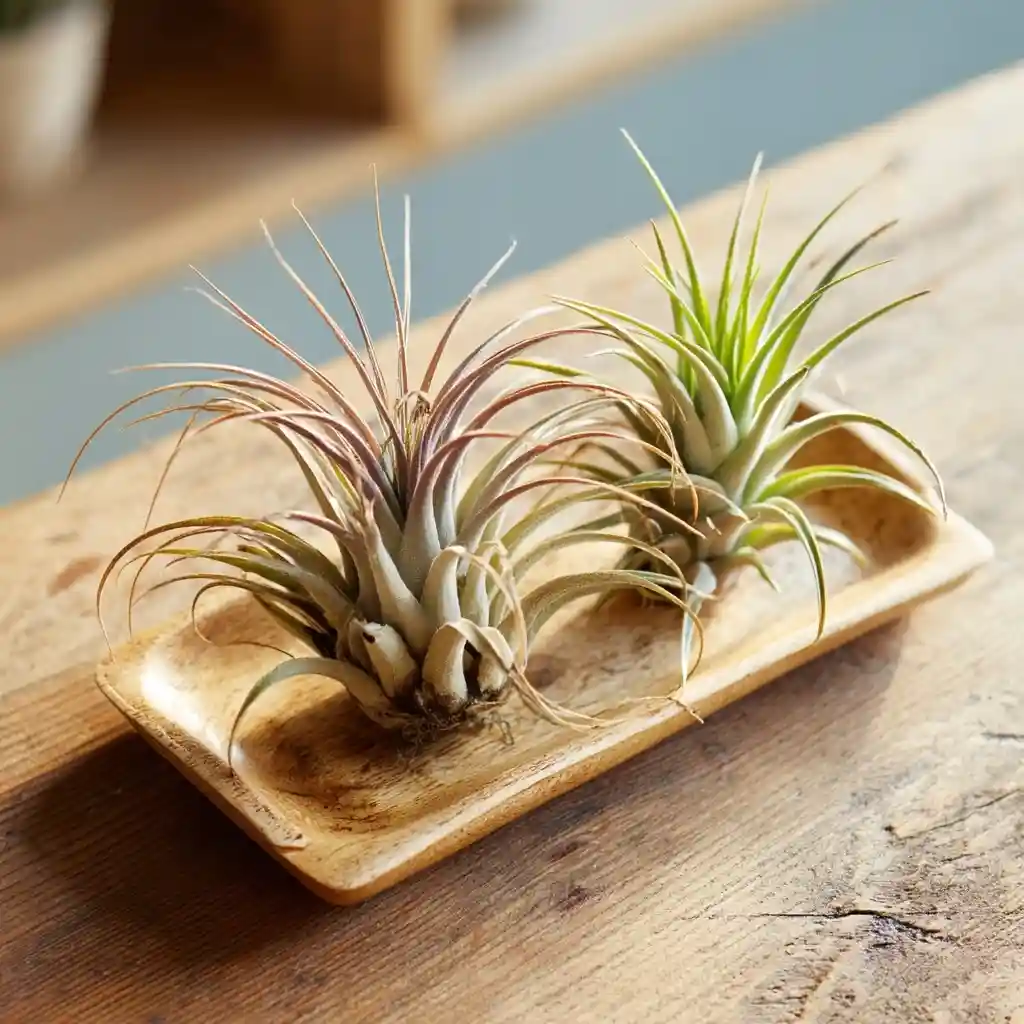Care for Air Plants starts with understanding their unique, soil-free lifestyle. These fascinating plants, often called Tillandsia, thrive without traditional potting mix, drawing nutrients from the air and moisture around them. That makes them perfect for indoor plant lovers who want low-maintenance greenery with a modern twist. Whether perched on driftwood or tucked into glass terrariums, air plants are as versatile in décor as they are resilient in nature.
In this guide, you’ll learn everything you need to know about how to care for air plants indoors—from choosing the right light and watering schedule to troubleshooting common problems and encouraging healthy blooms. Whether you’re a beginner or a seasoned plant parent, giving your air plants the best care is simpler than you might think.
Table of Contents
🌿 Care for Air Plants
Providing the right care for air plants is key to keeping them healthy, vibrant, and long-living. Though they’re famously low-maintenance, these unique plants still have specific needs when it comes to light, water, and humidity.
💡 Light
Air plants prefer bright, indirect light, much like what they’d receive under the tree canopy in their native tropical environments. A north- or east-facing window is ideal, or place them a few feet away from a sunny south-facing window. Direct sun for extended periods can scorch their leaves, while too little light may cause dull color and slow growth.
✅ Tip: Rotate your air plants every few days to ensure even light exposure.
🪴 Soil (or Lack of It)
One of the most interesting facts about air plants is they do not need soil. In fact, planting them in soil can be harmful. These epiphytes absorb nutrients and moisture through tiny scales on their leaves called trichomes. Instead of potting, place them on surfaces like wood, stone, or in hanging displays.
💧 Water
Watering is often the trickiest part of air plant care, but once you get the rhythm, it’s simple.
Here are three common watering methods:
- Soaking: Submerge your air plant in room-temperature filtered water for 20–30 minutes every 7–10 days. This is ideal for most species.
- Misting: Mist lightly 2–3 times per week if you live in a humid climate.
- Quick Dunk: Best for xeric varieties (from arid climates), a fast dip is less risky than prolonged soaking.
✅ Always shake off excess water and dry upside down to avoid trapped moisture, which can cause rot.
🌡️ Temperature and Humidity
Air plants thrive in temperatures between 50°F and 90°F (10°C to 32°C). Avoid placing them near cold drafts, heating vents, or in overly dry areas. Since they’re native to humid regions, they do best in rooms like bathrooms, kitchens, or near a humidifier.
If your indoor air is dry, increase humidity with:
- A nearby humidifier
- Grouping plants together
- Regular misting between soakings
🌿 Fertilizer
Though not always necessary, feeding air plants monthly can promote faster growth and more vibrant blooms. Use a bromeliad or air plant-specific fertilizer, diluted into your soaking or misting water.
Avoid general houseplant fertilizers, which may contain salts that can damage delicate trichomes.
🖼️ Displaying Your Air Plant
One of the best things about care for air plants is the creative freedom you get when displaying them. Because they don’t need soil or a traditional pot, your options are wide open—literally.
Here are several smart, stylish ways to show off your air plants:
🔸 Mounted Displays
Attach your air plants to:
- Driftwood
- Cork bark
- Tree branches
- Stone slabs
Use a dab of non-toxic glue or soft wire—just make sure the plant can be removed for watering.
🔸 Hanging Air Plant Holders
Hang them in:
- Geometric glass orbs
- Macramé air plant cradles
- Ceramic or metal wall holders
- Sea urchin shells (a favorite for Tillandsia ionantha)
These look great suspended near windows with bright indirect light.
🔸 Tabletop or Wall Decor
Place air plants:
- In shallow dishes with rocks, shells, or sand (no standing water)
- On bookshelves, window sills, or bathroom counters
- On mounted wall frames or mirrors for a natural art piece
🔸 Terrariums (With Care)
Mesic air plants (those from humid environments) can be placed in open glass terrariums with good airflow. Avoid closed terrariums, which trap too much moisture and can lead to rot. Also avoid using xeric varieties (from dry regions) in humid terrariums—they need more airflow and less moisture.
💡 Always make sure your display allows for easy removal during watering and adequate air circulation afterward.
🌱 Types of Air Plants
When talking about care for air plants, it’s important to know that the term “air plant” refers to a wide range of species—most notably those in the Tillandsia genus. But they’re not the only ones. Many epiphytes (plants that grow on other surfaces without soil) also fall under this category.
Here are some of the most popular types of air plants you might encounter:
🌸 Tillandsia (True Air Plants)
These are the most recognized air plants and come in two general types:
- Mesic Tillandsia – Native to humid rainforests. They have greener, softer leaves and prefer regular soaking or misting.
- Xeric Tillandsia – From drier environments. Their silvery, fuzzy leaves help them retain moisture. They need more light and less water.
Popular species:
- Tillandsia ionantha (compact, blushes red before blooming)
- Tillandsia xerographica (large, sculptural rosettes)
- Tillandsia caput-medusae (tentacle-like leaves)
🌿 Epiphytic Orchids
Many orchids, like Phalaenopsis, grow naturally on trees. While they’re often potted in bark mix when sold commercially, they are true epiphytes and can grow mounted, much like Tillandsia.
🌵 Epiphytic Cacti
Not all cacti live in deserts! Epiphytic cacti, like:
- Rhipsalis
- Fishbone cactus (Epiphyllum anguliger)
- Christmas cactus (Schlumbergera)
…come from rainforests and grow attached to trees. Their care differs slightly—they prefer higher humidity and filtered light.
🌿 Epiphytic Ferns
Some ferns grow just fine without soil. Examples include:
- Staghorn fern (Platycerium bifurcatum)
- Bird’s nest fern (Asplenium nidus)
These ferns can be mounted on boards or hanging plaques and require frequent misting to mimic their native, humid habitats.
📝 Not all epiphytes have identical care needs. Always research your specific species when setting up a care routine.
✂️ Pruning

Proper pruning is a small but meaningful part of care for air plants. While these plants don’t need frequent trimming like traditional houseplants, a bit of maintenance keeps them looking their best and helps prevent disease.
When to Prune Air Plants
Air plants naturally shed old or dried leaves from the base as they grow. But if you notice:
- Brown, crispy leaf tips
- Dead or damaged leaves
- Mushy or discolored parts after overwatering
…it’s time to give them a gentle trim.
How to Prune Safely
- Use clean, sharp scissors or garden shears. Disinfect them with rubbing alcohol to avoid spreading bacteria.
- Remove dead leaves by gently pulling them away from the base.
- Trim brown tips by cutting at an angle, mimicking the natural curve of the leaf.
- After a bloom fades, cut the flower spike near the base to encourage pup development.
⚠️ Avoid cutting healthy leaves or the central base (“heart”) of the plant—this can halt growth or kill the plant entirely.
After-Pruning Care
Once trimmed, allow the plant to dry thoroughly, especially if it was recently watered. Proper airflow and light will help it bounce back quickly.
💡 Pruning also improves aesthetics and allows light to reach healthy inner leaves more effectively.
🌿 Propagating Air Plants
One of the most rewarding parts of care for air plants is propagation. These fascinating plants naturally reproduce by producing small offshoots, or “pups,” which can grow into full plants over time. Propagation is easy, beginner-friendly, and a great way to expand your indoor garden.
🧬 Method 1: Division (Most Common)
This method works best with mature Tillandsia and similar epiphytes.
Steps:
- Wait until the mother plant has produced pups (small clones that grow from its base).
- Once the pups are about ⅓ the size of the mother, gently separate them.
- Hold the mother plant at the base, and slowly wiggle the pup free. If needed, use a clean, sharp knife or scissors.
- Let the pup dry for a few hours, then begin caring for it just like an adult plant.
📝 Don’t rush separation—if the pup resists, wait a bit longer.
🌱 Method 2: Stem Cuttings (For Certain Epiphytes)
Some non-Tillandsia air plants—like epiphytic cacti or orchids—can be propagated via cuttings.
Steps:
- Cut a healthy, 4–5 inch stem from the parent plant using sterilized scissors.
- Let the cutting dry in a shaded spot for 24 hours to form a callus.
- Place the base in filtered or distilled water (or mount it, depending on species).
- Provide bright, indirect light and change the water weekly if rooting in water.
Roots should begin forming in a few weeks, and you can then treat it like a full plant.
🌟 Patience Pays Off
Air plants grow slowly, so don’t expect immediate results. With the right care, though, your new pups will thrive and eventually bloom on their own.
🪴 Growing Air Plants in Pots
Even though they don’t need soil, you can still grow air plants in pots—you just need to think outside the traditional planter. Understanding how to pot them properly is an essential part of care for air plants indoors.
Can Air Plants Go in Pots?
Yes, but with one major rule: No soil, ever. Soil holds too much moisture and can lead to rot. Instead, air plants are “planted” by placing or mounting them in decorative containers that allow for airflow and easy removal for watering.
Best Containers for Air Plants
You can get creative with how you pot air plants. Here are some great container ideas:
- Glass terrariums (open, not sealed)
- Hanging ceramic holders
- Wood bowls or driftwood mounts
- Seashells or sea urchin shells
- Wire or metal baskets
✅ Always choose pots that don’t hold standing water and allow air to circulate.
Tips for “Potting” Air Plants Successfully
- Don’t bury the base or wedge it too tightly into the pot—it needs room to breathe.
- Keep pots in bright, indirect light (like a sunny windowsill).
- Remove the plant for watering, then let it dry completely before placing it back.
When to “Repot”
Air plants don’t outgrow pots like soil-based plants, but you might want to move them if:
- The display looks too crowded
- The plant becomes unstable or top-heavy
- You’re refreshing your décor
Just gently transfer them to a new holder—no roots to disturb!
🌿 The freedom from soil makes air plants some of the easiest “potted” plants to rearrange or relocate whenever you like.
🐛 Common Pests & Diseases
Although generally low-maintenance, care for air plants does involve being vigilant about pests and diseases. When problems do arise, it’s often due to poor airflow, excess moisture, or dry indoor conditions.
🐞 Common Pests
1. Mealybugs
- Tiny white insects that look like cotton.
- Hide in leaf crevices and suck plant sap, causing yellowing and leaf drop.
2. Scale Insects
- Appear as small brown or black bumps on leaves.
- Also feed on sap and weaken the plant over time.
🔍 Treatment: Dab pests with a cotton swab dipped in rubbing alcohol. Repeat every few days until pests are gone. Follow up with a light spray of neem oil to prevent reinfestation.
🦠 Fungal Issues & Rot
Overwatering or poor drying leads to:
- Root or base rot (soft, mushy areas; darkened leaves)
- Fungal growth from trapped moisture
🚫 Never let water collect in the base of the plant, and always let it dry completely—especially after soaking.
🌿 Prevention Tips
- Allow plants to fully dry upside down after watering.
- Keep air plants in well-ventilated spaces.
- Avoid misting too frequently in low-humidity environments.
- Use filtered or distilled water to avoid mineral buildup.
⚠️ Air plants are more vulnerable to rot than to pests—proper watering and drying are the most effective ways to keep them healthy.
🌸 Bloom
One of the most exciting milestones in care for air plants is witnessing them bloom. Though air plants only bloom once in their lifetime, the event is a visual treat and a sign that the plant is mature and healthy.
📅 When Do Air Plants Bloom?
There’s no fixed season. Blooming depends on:
- Species
- Age
- Growing conditions
Most Tillandsia species bloom once they’ve reached maturity, which can take several years. With the right care, however, many will bloom even in indoor environments.
⏳ How Long Does the Bloom Last?
- Small species: blooms may last a few days to a couple of weeks
- Larger air plants: blooms can last several months
- In rare cases, some species (like Tillandsia xerographica) may bloom for up to a year
🎨 What Do Air Plant Blooms Look Like?
Air plant flowers come in vibrant colors like:
- Red
- Pink
- Purple
- Orange
- Blue
Some varieties are even fragrant. For example:
- Tillandsia purpurea smells like cinnamon
- Tillandsia duratii has a sweet, grape soda-like scent
🌟 Encouraging Blooms
To increase the chance of blooming:
- Provide bright, indirect light
- Stick to a consistent watering schedule
- Fertilize monthly with a bromeliad-safe fertilizer
- Avoid cold drafts and ensure good humidity levels
🔁 Blooming often signals that the plant will soon produce pups (baby plants) before eventually dying back. This is part of its natural life cycle.
✂️ Post-Bloom Care
Once the bloom fades:
- Trim the flower spike near the base using sterile scissors.
- Continue with regular care.
- Watch for pups to emerge around the base.
🌱 With proper care, your air plant’s legacy continues through its offshoots—even after the main plant has bloomed and faded.
⚠️ Common Issues with Air Plants
Even with proper care for air plants, problems can occasionally crop up—usually due to watering mistakes, dry air, or lack of light. The good news? Most issues are preventable and fixable if caught early.
🍂 Browning Leaf Tips
Cause: Low humidity or insufficient watering
What it looks like: Dry, crispy ends on the leaves
How to Fix:
- Increase humidity by misting or placing a humidifier nearby.
- Soak more frequently if your climate is dry.
- Move your plant away from heaters or direct sun.
📝 Minor browning is normal with age, but widespread dryness means the plant is stressed.
🌧️ Mushy or Rotting Base
Cause: Overwatering or not drying upside down
What it looks like: Soft, squishy leaves near the base or blackened areas
How to Fix:
- Remove mushy or rotted parts with sterilized scissors.
- Skip the next watering and let the plant fully dry.
- Adjust your watering schedule moving forward.
⚠️ Rot is the #1 killer of air plants—always prioritize proper drying.
🌫️ Dull Color or Lack of Growth
Cause: Low light, poor air circulation, or nutrient deficiency
What it looks like: Pale, limp leaves or little to no new growth
How to Fix:
- Move the plant to a brighter location with indirect light.
- Fertilize monthly with an epiphyte-safe formula.
- Ensure good airflow around the plant.
👀 Quick Troubleshooting Table
| Problem | Likely Cause | Solution |
|---|---|---|
| Brown, crispy tips | Dry air / under-watering | Mist more often or soak longer |
| Mushy stems / rot | Overwatering | Trim, dry thoroughly, reduce watering |
| Dull or pale color | Low light or poor care | Brighten location, fertilize monthly |
| Slow growth | Low nutrients | Add monthly feedings |
❓ FAQ: Air Plant Care Questions Answered
Even with all the tips on care for air plants, questions come up—especially for beginners. Here are some of the most commonly asked questions and clear, practical answers.
🪴 Do air plants really not need soil?
Correct. Never plant air plants in soil. They absorb water and nutrients through their leaves, not roots. Soil can suffocate them and lead to rot.
💧 How often should I water my air plant?
Most air plants need soaking once a week or misting several times a week depending on humidity. In dry climates, they may need more frequent misting or longer soaks.
☀️ Can I grow air plants in a dark room?
Not successfully. Air plants need bright, indirect light to thrive. A room with no natural light will require a grow light.
🪫 Why is my air plant turning brown?
Likely causes:
- Underwatering
- Low humidity
- Exposure to direct sun
- Fertilizer burn
Fix the environment and trim any dead tips to help it recover.
🌱 Will my air plant keep growing forever?
Air plants are monocarpic, meaning they bloom once and then begin to die. But before that, they’ll produce “pups”—new baby plants you can separate and grow on.
🌡️ Can air plants survive cold winters?
Only indoors. Air plants are tropical, and temperatures below 45°F (7°C) can damage or kill them. Keep them away from drafts and cold windows during winter.
🌼 Final Thoughts on How to Care for Air Plants
Providing the right care for air plants is easier than most people think. With no need for soil and minimal watering requirements, these resilient beauties are perfect for plant lovers of all skill levels. Whether displayed in a hanging terrarium, mounted on driftwood, or tucked into a seashell on your desk, air plants bring a touch of nature and creativity to any indoor space.
By giving them the right light, humidity, and occasional feeding, you’ll enjoy healthy plants that grow, bloom, and even multiply over time. With patience and proper attention, your air plant collection can thrive year-round—no green thumb required.


